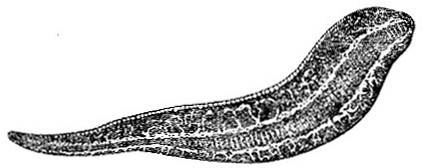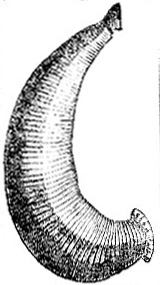1902 Encyclopedia > Annelida > IV. Annelida Discophora (cont.): Annelida Discophora: Reproductive System. No Replacement of Lost Parts. Distribution. Fossil Remains. A Note on Classification.
Annelida
(Part 11)
IV. Annelida Discophora (cont.)
Annelida Discophora: Reproductive System. No Replacement of Lost Parts. Distribution. Fossil Remains. A Note on Classification.
The Discophora are hermaphrodite (with the exception of the Malacobdellidoe and Histriobdellidoe), with the male organs ranged along the ventral surface in the form of a series of testes, which are connected with a common vas deferens leading into a vesicular seminalis on each side. The latter conveys the fluid into the intromittent organ, and its secretion agglutinates the spermatozoa into a seminal rope or spermatophore. The female organs consist of two ovaries leading to a common duct, opening into the vagina, which receives the spermatophore. The segmental organs are present, but not in direct communicaiton with the reproductive structure, nor do they carry the products to the exterior, since they are often caecal. The foregoing diverges from the arrangement in the other Annelida, since the generative products are not extruded into a perivisceral cavity, but pass outwards by a particular apparatus. The ova are deposited in capsules formed by special secretions, those of the leech being called cocoons. No metamorphosis occurs in the development of the young, which by-and-by, in some cases, attach themselves in crowds to the abdominal surface of the parent.

Fig. 18 -- Hirudo medicinalis, L., var. officinalis. The green leech.

Fig. 20 -- Bdella nilotica, Sav. (After Savigny.)
The Discophora do not possess much power of regenerating lost parts. They are distributed everywhere, chiefly in fresh water and moist places; some are marine. A few attain a large size, e.g., a species from Valdivia is described as being two and a half feet long. Many are ectoparasitic, living on fishes, crabs, and even in jelly fishes (Bolinidae). In swampy ground in tropical countries certain leeches are often troublesome to travelers. Fossil leeches have been found in the lithographic stones of Germany. They have been grouped into five families, viz., Malacobdellidae, Histriobdellidae, Acanthobdellidae, Branchiobdellidae, and Rhynchobdellidae-the latter including the medicinal leech of Europe, the green leech (fig. 18), the Bdella nilotica of Savigny (fig. 19), the horse-leech, skate-leech, pond-leech, which is devoid of an anterior sucker, and other well-known forms.
Read the rest of this article:
Annelida - Table of Contents
|

